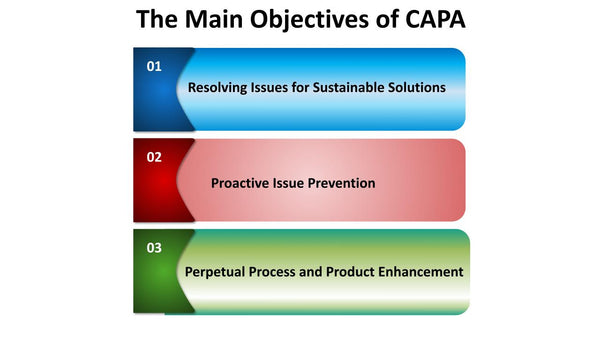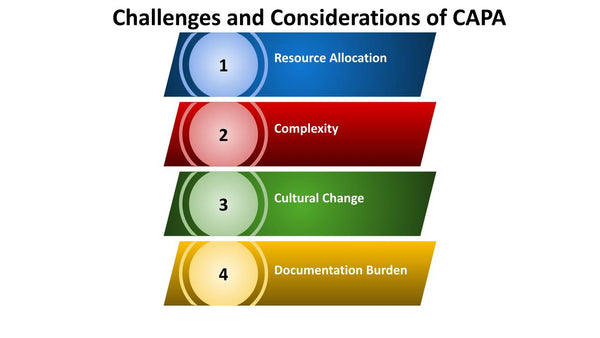Mastering CAPA: Your Guide to Corrective and Preventive Actions
In the dynamic world of quality management and regulatory compliance, CAPA stands as a critical acronym that holds immense significance for organizations across various industries. CAPA stands for Corrective and Preventive Actions, a structured and systematic approach to identifying, addressing, and preventing issues that can affect product quality, compliance, and overall business performance. In this comprehensive guide, we will delve deep into the world of CAPA, exploring its meaning, importance, key components, best practices, and how organizations can leverage it to enhance quality, compliance, and continual improvement.

Understanding CAPA
CAPA, or Corrective and Preventive Actions, is a fundamental concept in quality management systems (QMS) and regulatory compliance. It represents a structured methodology for addressing problems, non-conformities, and deviations from established standards or procedures. The main objectives of CAPA are:
- Resolving Issues for Sustainable Solutions: Effectively addressing and rectifying problems to ensure long-term solutions.
- Proactive Issue Prevention: Taking preemptive measures to mitigate potential problems and avoid their occurrence altogether.
- Perpetual Process and Product Enhancement: Consistently improving and refining processes and products to achieve ongoing excellence.
CAPA is not merely a reactive process; it's a proactive approach to quality management that encompasses both corrective and preventive measures.
Key Components of Corrective Action
Effective corrective action involves several key components, each of which contributes to its success:
- Problem Identification: The process begins with the identification of a problem, non-conformity, or deviation from established standards. This can be initiated through customer complaints, internal audits, or other quality control mechanisms.
- Root Cause Analysis: Corrective action aims to address the underlying causes of the problem, not just its symptoms. Root cause analysis techniques such as the "5 Whys" or Fishbone Diagrams are often used to identify the true source of the issue.
- Action Plan: Once the root cause is identified, an action plan is developed to address the problem comprehensively. This plan outlines the specific steps to be taken, responsibilities, timelines, and resources required.
- Implementation: The action plan is put into action, with individuals or teams executing the identified steps to resolve the problem. Effective communication and coordination are essential during this phase.
- Verification: After implementing the action plan, organizations verify that the corrective actions have been successful in eliminating the problem. This may involve additional testing, inspections, or data analysis.
- Preventive Measures: To prevent the problem from recurring, organizations implement preventive measures. These measures are designed to address the root cause and strengthen the overall system or process.
- Documentation: Thorough documentation of the entire corrective action process is essential. This includes records of the problem, root cause analysis, action plans, implementation details, verification results, and preventive measures.
- Continuous Improvement: Corrective action is closely tied to the concept of continuous improvement. Organizations should use the lessons learned from the process to enhance their systems, processes, and quality management practices continually.
Steps in Implementing Corrective Action
Implementing an effective corrective action process requires a structured approach. Here are the steps involved:
- Problem Identification: Start by identifying the problem or non-conformity. This can be initiated through customer feedback, internal audits, quality control inspections, or other means.
- Immediate Containment: If the problem poses an immediate threat, take containment actions to prevent further issues. This may involve isolating affected products or services.
- Root Cause Analysis: Conduct a thorough root cause analysis to determine why the problem occurred. Use techniques like the "5 Whys," Fishbone Diagrams, or Failure Mode and Effects Analysis (FMEA).
- Develop an Action Plan: Based on the findings from the root cause analysis, create a detailed action plan that outlines the specific steps to be taken, responsible parties, timelines, and required resources.
- Implement the Plan: Execute the action plan, making sure that all necessary steps are carried out as intended. Effective communication and collaboration among teams are crucial during this phase.
- Verify Effectiveness: After implementing the corrective actions, verify their effectiveness. This may involve retesting, inspections, or data analysis to ensure that the problem has been resolved.
- Prevent Recurrence: Implement preventive measures to address the root cause and strengthen the system or process to prevent similar issues from occurring in the future.
- Documentation: Maintain detailed records of the entire corrective action process, including problem reports, root cause analyses, action plans, implementation details, verification results, and preventive measures.
- Review and Continuous Improvement: Periodically review the effectiveness of the corrective action process itself and look for opportunities to improve it. Incorporate lessons learned into future corrective actions.
CAPA in Regulatory Compliance
CAPA plays a vital role in ensuring regulatory compliance, especially in highly regulated industries such as healthcare, pharmaceuticals, and aerospace. Regulatory bodies like the FDA (Food and Drug Administration) require organizations to have robust CAPA processes in place to:
- Address deviations from regulatory requirements.
- Investigate product quality issues.
- Implement corrective actions to prevent recurrence.
- Demonstrate compliance with regulations through documentation.
Advantages of Implementing CAPA
Implementing a robust CAPA system offers numerous benefits to organizations:
- Improved Quality: CAPA helps organizations identify and address quality issues, leading to improved product quality and customer satisfaction.
- Reduced Costs: By preventing problems and defects, CAPA reduces the cost of rework, recalls, and customer complaints.
- Compliance: CAPA ensures that organizations meet regulatory requirements and maintain compliance with industry standards.
- Enhanced Reputation: Effective CAPA processes demonstrate a commitment to quality and customer satisfaction, enhancing an organization's reputation.
- Risk Management: CAPA helps organizations identify and mitigate risks, reducing the likelihood of costly incidents or regulatory violations.
- Data-Driven Decision-Making: CAPA processes provide valuable data and insights that can inform strategic decision-making and continuous improvement initiatives.
Optimal Approaches for Implementing CAPA
Successful CAPA implementation relies on the following best practices, including:
- Management Commitment: Ensuring top management's commitment to CAPA is vital for allocating resources and fostering a culture of quality.
- Training and Education: Providing training and education to employees involved in CAPA processes to enhance their skills in problem-solving and root cause analysis.
- Documentation: Maintaining detailed records of all CAPA activities, including problem reports, investigations, action plans, implementation details, and verification results.
- Cross-Functional Teams: Involving cross-functional teams in CAPA activities to gain diverse perspectives and expertise.
- Technology Utilization: Leveraging technology and CAPA software to streamline processes, track progress, and enhance data analysis.

Challenges and Considerations of CAPA
While CAPA offers significant benefits, it is not without its challenges and considerations:
- Resource Allocation: Implementing and maintaining CAPA processes can require significant time, manpower, and financial resources.
- Complexity: CAPA processes can be complex, and organizations may need specialized expertise to navigate them effectively.
- Cultural Change: Achieving a culture of quality and continuous improvement may require a shift in organizational culture and mindset.
- Documentation Burden: Maintaining comprehensive documentation throughout the CAPA process can be time-consuming.
Conclusion
Corrective action is a fundamental process that organizations use to identify, address, and prevent problems and non-conformities. It plays a pivotal role in quality improvement, customer satisfaction, cost reduction, and regulatory compliance. By following a structured approach, including problem identification, root cause analysis, action planning, implementation, verification, and preventive measures, organizations can effectively resolve issues and continually enhance their processes and systems. Corrective action is not just a reactive process; it is a proactive approach to building a culture of excellence and continuous improvement within an organization, ultimately leading to greater success in today's competitive business environment.

